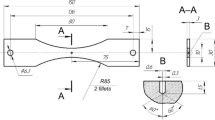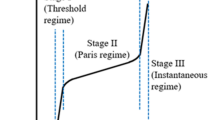Abstract
Based on the idea that the fatigue damage is caused by the cyclic damage strain, a concept of the critical damage quantity is introduced and a new three-parameter model is developed. The model contains three material performance parameters, i.e., the fatigue ductility coefficient, the fatigue ductility exponent, and the theoretical strain endurance limit. The fatigue ductility coefficient reflects the existence of the critical damage quantity. The fatigue ductility exponent shows the damage resistance ability of the material. And the theoretical strain endurance limit represents the existence of the critical cyclic strain. By using the proposed model, the fatigue crack initiation life of metallic materials can be predicted.



















Similar content being viewed by others
Abbreviations
- N i :
-
fatigue crack initiation life
- Δεp :
-
cyclic plastic strain range
- ΔεD :
-
cyclic damage strain range
- c :
-
fatigue ductility exponent
- \( \upsigma_{\text{f}}^{\prime } \) :
-
fatigue strength coefficient
- εf :
-
fracture ductility
- σ−1 :
-
stress endurance limit
- Δε:
-
cyclic strain range
- Δεe :
-
cyclic elastic strain range
- Δεc :
-
theoretical strain endurance limit
- \( \upvarepsilon_{\text{f}}^{\prime } \) :
-
fatigue ductility coefficient
- b :
-
fatigue strength exponent
- σb :
-
ultimate tensile strength
- E :
-
Young’s modulus
References
N.E. Dowling, W.R. Brose, and W.K. Wilson, Notched Member Fatigue Life Predictions by the Local Strain Approach, Adv. Eng. Fatigue Under Complex Loading, 1977, 6, p 55–84
S.S. Manson, Fatigue, A Complex Subject-Some Simple Approximation, Exp. Mech., 1965, 5(7), p 193–226
S.S. Manson, Interfaces Between Fatigue, Creep and Fracture, Proceedings of the First International Conference on Fracture, Sendai, Japan, Japanese Society for Strength and Fracture of Materials, 1966, p 1378–1432
S. Kocanda, Fatigue Failure of Metals, Alphen aan den Rijn, Sijthoff-Noordhoff International Publishers, The Netherlands, 1978
X.-L. Zheng, Quantitative Theory of Metal Fatigue, Northwestern Polytechnic University Publishing House, Xi’an, China, 1994 (in Chinese)
X.-L. Zheng, Modeling Fatigue Crack Initiation Life, Int. J. Fatigue, 1993, 15(6), p 461–466
X.-L. Zheng, On Some Basic Problems of Fatigue Research in Engineering, Int. J. Fatigue, 2001, 23, p 751–766
X.-L. Zheng, A Further Study on Fatigue Crack Initiation Life-Mechanics Model for Fatigue Initiation, Int. J. Fatigue, 1986, 8(1), p 17–21
X.-L. Zheng and B. Lu, Fatigue Formula Under Cyclic Strain Fatigue and Fracture Mechanics, Proceedings of the 1st International Conference, Localized Damage Computer Aided Assessment and Control, Portsmouth, June 1990, p 175–184
L.F. Coffin, Jr., and N.Y. Schenectady, A Study of the Effects of Cyclic Thermal Stresses on a Ductile Metal, Trans. ASME, 1954, 76, p 931–950
L.F. Coffin, Jr, and J.F. Tavernelli, The Cyclic Straining and Fatigue of Metals, Trans. Metall. Soc. Am. Inst. Mining Metall. Petroleum Eng., 1959, 215, p 794–807
N.E. Frost, K.J. Marsh, and L.P. Pook, Metal Fatigue, Clarendon Press, Oxford, 1974
S.I. Hong and C. Larid, Fatigue Crack Initiation and Growth Behavior of Cu-16% Atom Aluminum Single Crystals, Fatigue Fract. Eng. Mater. Struct., 1991, 14, p 143–169
Science and Technology Committee of Aeronautic Engineering Department, Handbook of Strain Fatigue Analysis, Science Publishing House, Beijing, China, 1987 (in Chinese)
T.H. Topper, R.M. Wetzel, and J.D. Morrow, Neuber’s Rule Applied to Fatigue of Notched Specimens, J. Mater., 1969, 4(1), p 200–209
T. Endo and J.D. Morrow, Cyclic Stress-Strain and Fatigue Behavior of Representative Aircraft Metals, J. Mater., 1969, 4(1), p 159–175
L. Tucker, S. Dowling, and L. Camillo, Accuracy of Simplified Fatigue Prediction Methods, Adv. Eng. Fatigue Under Complex Loading, 1977, 6, p 137–144
C.E. Feltner and M.R. Mitchell, Basic Research on the Cyclic Deformation and Fracture Behaviour of Materials, Manual on Low Cycle Fatigue Testing, ASTM STP 465, Philadelphia, ASTM, 1969, p 27–66
D.E. Martin, An Energy Criterion for Low Cycle Fatigue, J. Basic Eng. Trans. ASME, 1961, Dec, p 565–571
Author information
Authors and Affiliations
Corresponding author
Rights and permissions
About this article
Cite this article
Zhang, Z., Sun, Q., Li, C. et al. A New Three-Parameter Model for Predicting Fatigue Crack Initiation Life. J. of Materi Eng and Perform 20, 169–176 (2011). https://doi.org/10.1007/s11665-010-9667-4
Received:
Revised:
Published:
Issue Date:
DOI: https://doi.org/10.1007/s11665-010-9667-4




